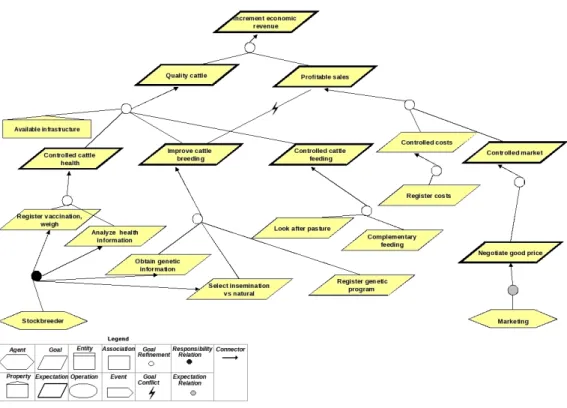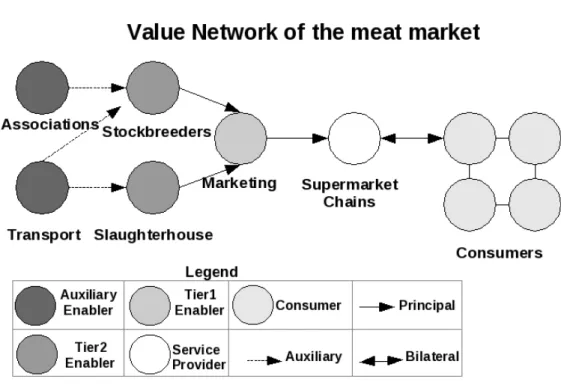Je tiens également à remercier toute l'équipe ADELE : Eric Simon, German Vega, Jacky Estublier, Philippe Lalanda, Didier Donsez, Kiev Gama, Vincent Lestideau, Etienne Gandrille, Elmehdi Damou, Yoann Maurel et Jonathan Bardin et Sylvie Bellet. Merci à François Rechenmann de m'avoir instruit à la « lumière de l'expérience » dans le processus de thèse, à Pierre Andreani pour son aide dans la définition de la suite de mon parcours professionnel, et à Annie Culet pour son soutien tout au long de notre séjour en France.
Research Approach
Our interest is centered on model-driven RE, and the challenge is to define the RE requirements considering not just one organization, but a composite of organizations. The proposal consists of exploring, collecting and visualizing the information that meets the requirements of diverse stakeholders, users, analysts, etc.
Research Contributions 3
Research Contributions
Structure of the Thesis
Chapter 3 presents a state of the art of VOs from a business perspective by describing several ICT projects and platforms dedicated to VOs. Chapter 4 presents a more advanced requirements engineering of the model seen in [Priego-Roche et al., 2010].
Cattle Union: a case study
- The Case Study
- Stockbreeders
- Stockbreeders Associations 7
- Stockbreeders Associations
- Meat Marketing
- Cattle Slaughtering and Processing
- Credit Union
- Retail Stores 9
- Retail Stores
- Dairy Product Manufacturing
- Veterinary Laboratory
- Animal Food Manufacturing
- Freight Trucking
- Butcher Stores
- Livestock product buyers and suppliers
- Other buyers and suppliers 11
- Other buyers and suppliers
- External organizations
- Complementors and competitors
- Support and regulatory institutions
- The assembled organizations
- The assembled organizations 13
At least half the carcasses are processed into packaged beef, chilled or frozen for shipment to retail centers. Membership requires an annual membership fee, which facilitates access to the general public.

ULSSA
CFPP
Virtual Organization: State of the Art
Introduction
VO “an organizational innovation that identifies production needs regardless of how they can be met. VO "refers to a temporary or permanent collection of geographically dispersed individuals, groups, organizational units - which make or belong to the same organization - or entire organizations that depend on electronic communication to complete the production process" [Travica , 1997 ].

Virtual Organization Characterization 17
Virtual Organization Characterization
- Strategy
It focuses on continuous assessment of external and internal conditions in order to make the necessary adjustments in the organization. In [Pfeffer et al., 2003], a summary of theories about organizations and their relationship with environments is presented.
Virtual Organization Characterization 19
- Strategic Frameworks
- Alliances
Internally focused on the company (e.g. Value Chain Analysis (M. Porter and V. Millar, 1985), Core Competencies Matrix (G. Hamel and C.K. Prahalad, 1994)). Bridging focused between the company and its environment (eg Alliance Value Creation (Y. Doz and G. Hamel, 1998), Assumption Led Strategy (J. Sampler and M. Blosch, 2002)).
![Figure 3.3: Three strategic framework groups (adapted from [Woolfe et al., 2002]) Enterprise analysis (e.g., Bench marking from C](https://thumb-eu.123doks.com/thumbv2/1bibliocom/464926.70304/40.892.143.715.171.486/figure-strategic-framework-adapted-woolfe-enterprise-analysis-marking.webp)
Virtual Organization Characterization 21
- Alliance typology
- Business typology
They are not limited to two companies, recently multipartner alliances are more common [Elmuti et al., 2001, Lavie et al., 2008]. Usually this is a viable option when the licensor does not have the money to invest in the plants for the production of a product (product, patent licensing) or there is accelerated demand for new technologies (technology, software licensing) or for the expansion or building a marketing image (copyright, brand licensing) [Hastbacka et al., 1998, Frank, 2004].
Virtual Organization Characterization 23
- ICT typology
For example, in a consortium there is a medium cooperation that focuses on reducing transaction costs, more autonomy between organizations, a low and limited operability aimed at facilitating cooperation without much involvement, not necessarily in a long-term alliance expensive and with a tendency towards equal power. It can be noted that there is a tendency towards close cooperation and more autonomy between the organizations, that there is limited interoperability between the organizations (fairly low), and that they form a long-term alliance with a balanced power among the participants (above weak ).
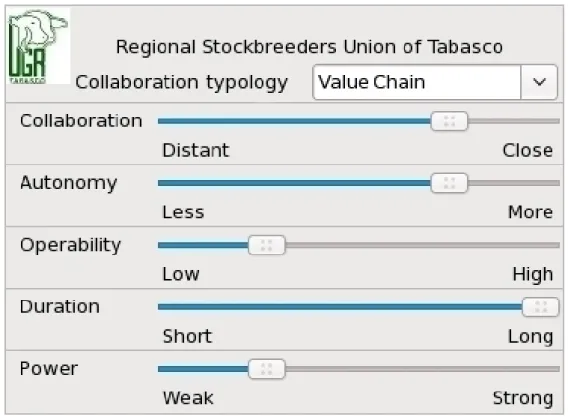
Virtual Organization Characterization 25
In the virtual space, the cyber organization is viewed and the provider organizations can also be revealed. The broker organization is displayed in the virtual space, while the information sources are not relevant.
![Figure 3.6: Alliance models from electronic business [Burn et al., 1999]](https://thumb-eu.123doks.com/thumbv2/1bibliocom/464926.70304/46.892.146.716.627.960/figure-alliance-models-from-electronic-business-burn-1999.webp)
Virtual Organization Characterization 27
- Systems of Systems as an approach to alliances
- Alliance life cycle
Different areas of the component systems provoke different perspectives of the same concept (a "customer" is different for a slaughterhouse than for a supermarket) as well as some individual skills at the time of use in different areas (for example payments from suppliers) . Each criterion of the table is compared with an individual system and with multiple systems.
Virtual Organization Characterization 29
- A life cycle as a human relation
This process description emphasizes the human relationship rather than cold-blooded judgments that can mislead the alliance if both views are not well balanced. Housekeeping: Organizations realize that "they have different ideas about how the business should work," so problems arise from day-to-day activities (even with previous compatibility assessment) and need to be addressed.
![Figure 3.7: Alliance life cycle [Kanter, 1994]](https://thumb-eu.123doks.com/thumbv2/1bibliocom/464926.70304/50.892.134.723.434.566/figure-3-7-alliance-life-cycle-kanter-1994.webp)
Virtual Organization Characterization 31
- A life cycle as a network
- A life cycle supported by tools
- A life cycle for VO
Among the tools and templates developed are business cases, value chain and production and partner analysis and needs, analysis checklist. Tools include a Relationship Assessment Form, Annual Status Report, Contract Termination Checklist, Termination Planning Worksheet.
![Figure 3.9: Alliance life cycle [Dyer et al., 2001]](https://thumb-eu.123doks.com/thumbv2/1bibliocom/464926.70304/52.892.147.725.228.353/figure-alliance-life-cycle-dyer-et-al-2001.webp)
Virtual Organization projects 33
Virtual Organization projects
- SMEcoll
The collaborative environment in the Internet space is a workplace for sharing information with limited access to the people involved in the project. Other tools such as document sharing, workflow, contacts, calendars, communication (videoconferencing and conferencing) and task management are available with special configuration for the organizations involved in the project.
Virtual Organization projects 35
- ECOLEAD project
It includes small and medium-sized enterprises (SMEs), research and development partners and industrial support organizations. This project proposes a modeling framework called A Reference model for COllaborative Networks (ARCON) [Camarinha-Matos et al., 2007a], aiming to represent a holistic view of CNOs through many dimensions and tools discussed in the following sections are described.
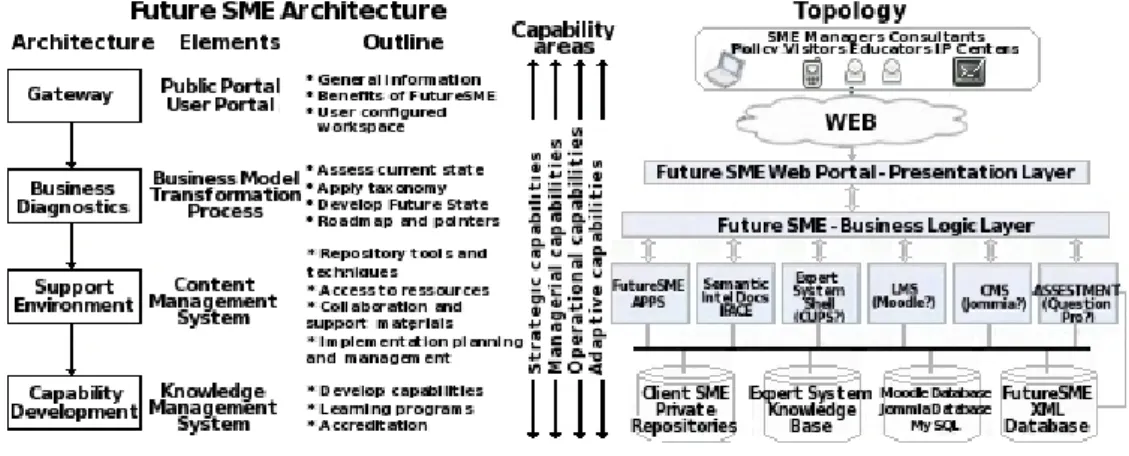
Virtual Organization projects 37
All the concepts presented above are mapped to the VO life cycle [Camarinha-Matos et al., 2003], described in subsection 3.2.5.4. A dynamic tool to help create a VO is designed to quickly create a new one using trust, competencies, business processes and candidate past performance data.
![Figure 3.13: The ARCON framework multiple dimensions [Camarinha-Matos et al., 2008]](https://thumb-eu.123doks.com/thumbv2/1bibliocom/464926.70304/58.892.212.657.279.563/figure-the-arcon-framework-multiple-dimensions-camarinha-matos.webp)
Technology Platforms 39
- VO projects summary
Technology Platforms
- BEinGRID project
Technology Platforms 41
- TrustCoM project
The responsible organization for this component is the University of Kent (UKent)[37]: it is a web service for maintaining an entity's reputation. The former creates all necessary tables and initializes them to the reputation service according to a given database schema.
Technology Platforms 43
- SYNERGY project
- VO technology platforms summary
It consists of operations such as ordering, selecting, consuming, detecting overlaps and inferring events. Ad-Hoc Workflow Engine (Ad-Hoc Wf): Organizes the execution of the collaboration pattern defined in CPats.
![Figure 3.15: The SYNERGY conceptual architecture [SYNERGY, 2009]](https://thumb-eu.123doks.com/thumbv2/1bibliocom/464926.70304/64.892.166.706.544.871/figure-15-the-synergy-conceptual-architecture-synergy-2009.webp)
Technology Platforms 45
Model based Requirement Engineering
Introduction to Requirement Engineering
Elicitation: discovering the problem to be solved and determining the boundaries of the system. Modeling and analysis: building an abstract description of what needs to be considered and analyzed.
Requirement Engineering Elicitation Techniques 49
Requirement Engineering Elicitation Techniques
This method was used in IS for software user testing [Henderson et al., 1995] which consisted of identifying the important concepts of the project from the registered material. Text analysis helps elicit early requirements by revealing features in the text that facilitate the identification of key concepts for understanding the problem domain [Sawyer et al., 2005].
Requirement Engineering Elicitation Techniques 51
Model Driven Techniques
- A framework definition
Model Driven Techniques 53
- Goal based approaches
We use the value scale proposed by [Al-Subaie et al., 2006]: Completely, Strongly, Partially and Slightly. Goal-oriented requirements engineering (GORE) is based “on the identification of system goals and the transformation of these goals into requirements” [Al-Subaie et al., 2006].
Model Driven Techniques 55
- KAOS [van Lamsweerde et al., 1998]
Marketing must "Report Aftersales" (a task) to the Breeder and must provide a "Payment" (a resource) to the Breeder for the cattle sold. KAOS aims to support the requirements formulation process by “acquiring knowledge about the complex system involving concepts not usually found in the final formal specification, such as objectives to be achieved, agents to be involved and their responsibilities, etc. . composite system refers to the application to be automated and its environment)” [Dardenne et al., 1991].
Model Driven Techniques 57
A method for creating requirements that starts with identifying a high-level goal, defining it precisely, and evaluating the positive/negative contribution to the goal through a process of refinement until all necessities can be assigned, followed by the identification of the objects involved and the operations to be used . to reach the goal. And finally, responsibility assigns operations to agents and helps define system boundaries.
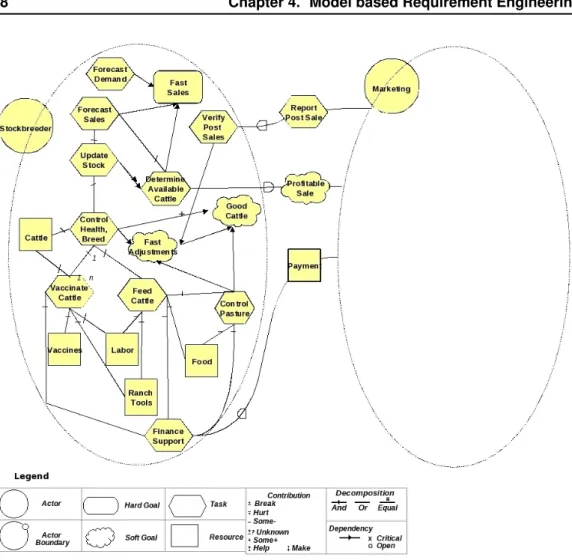
Model Driven Techniques 59
- Map [Rolland et al., 2000]
Model Driven Techniques 61
- Scenario, Service, Value based approaches
- Scenario based: CREWS [Maiden, 1998]
They are generally described in natural language, however Maiden [Maiden et al., 2007b] suggested the use of graphic symbols and multimedia (video, text, sound and images) to enrich the description. The Analyzing Requirements Trade-offs: Scenario Evaluations (ARTScene) [Maiden et al., 2007b] proposes the use of multimedia (video, text, sound and images) in mobile devices (personal digital assistants (PDAs), smartphones and wireless technology) to eliciting workplace requirements from stakeholders.
Model Driven Techniques 63
- Service based: Service Value Networks [Basole et al., 2008]
Model Driven Techniques 65
- Value based: e 3 value [Gordijn, 2002]
- Model based approaches: a comparative analysis
All these approaches refer to the RE elicitation problem guided by goals, scenarios, services or values. In particular, we can observe the dependence among actors of i*, the top-down approach to target identification.
![Figure 4.13: e 3 value Meta Model [Gordijn et al., 2003]](https://thumb-eu.123doks.com/thumbv2/1bibliocom/464926.70304/86.892.149.710.149.642/figure-13-value-meta-model-gordijn-et-2003.webp)
Model Driven Techniques 67
Therefore, the motivation of this research work is to organize the VO requirements around concepts that provide a model-based RE methodology specifically focused on VO, which is detailed in the following chapters.
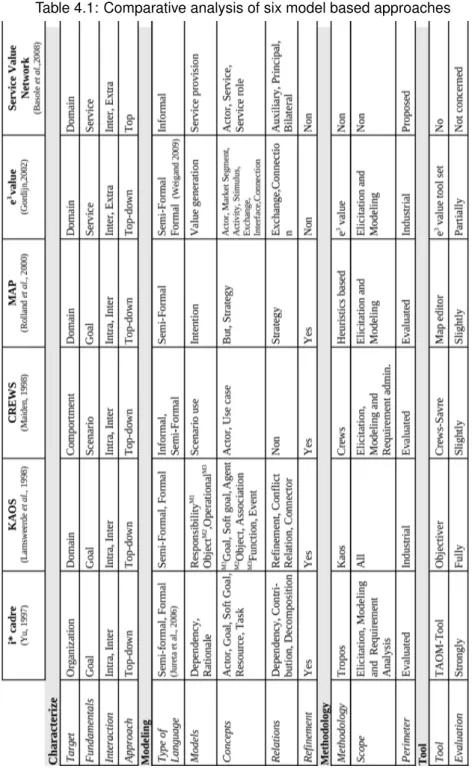
A 360˚ vision for VO: general framework
- Introduction
- VO characteristics
- VO characteristics 71
- Aspects exploration 73
- Aspects exploration
- The vertical aspects of analysis
- The vertical aspects of analysis 75
- The horizontal levels of analysis
- The horizontal levels of analysis 77
- Research Approach
- Research Approach 79
The situational information relevant to the application and its users must be educated. This requires the identification of the actors to be involved and the service they wish to offer.

A 360˚ vision for VO: intentional level aspects
Alliance Identification
- Organization
The Alliance Identification aspect consists of three sub-aspects detailed below and illustrated in Figure 6.2. At the Inter level, the functional actors of each organization that participate in the provision of the service and at the Extra level, the environmental organizations that influence the service.
Alliance Identification 85
- Offer
This can be the role of providing or using the service (ie the relationship of the member organization or participating organization to the service). These roles also have an impact on the service, which can be essential (without which the service cannot be achieved) or secondary (in addition, it facilitates the achievement of the service).

Alliance Identification 87
Table 6.2 presents the graphical representation of the Alliance Identification aspect, inspired by [Basole et al., 2008] for the three horizontal levels: Inter, Intra and Extra. Circles represent actors, committees and organizations. The different filling patterns of the circles represent the roles of the organizations in service delivery.
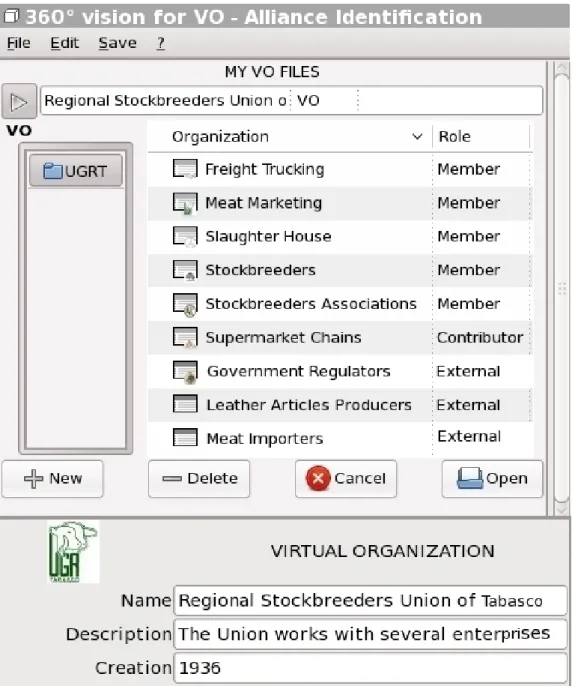
Alliance Identification 89
- Alliance
Alliance Identification 91
The latter means less interest in changing partners and, consequently, a long-term tendency to connect [Burn et al., 1999]. Exposed facade between the VO and its customers or users: screen (only the VO is seen), half screen (the VO and all or some organizations are seen) and mirror (only the organizations are clearly shown) [Burn et al., 1999].
Alliance Identification 93
For example, Figure 6.10 shows the set of organizations that form the VO association from our case study, based on an adaptation of the modeling language [Basole et al., 2008]: member organizations (livestock farmers, livestock associations, slaughterhouse, Freight transport, marketing) and participating organizations (supermarket chains and meat consumers), all of which make up the "Preparation and sale of quality beef" service. Figure 6.11 shows a graphic representation with external organizations: meat importers, leather goods manufacturers and government regulators who are competitors, complements and regulators.

Alliance Identification 95
Collaboration Willingness 97
Collaboration Willingness
- Engagement
Table 6.4 shows the graphical representation of the Willingness to Cooperate aspect at the Inter level, for the Engagement sub-aspect the square bounded by continuous lines represents the availability; the square bounded by dashed lines makes it for investments. Figure 6.14 illustrates an example of the engagement model for the member organization "Stockavler" with regard to accessibility (6.14a) and investments.

Collaboration Willingness 99
- Coordination
Each element coordinated by a member organization is characterized in terms of space, time, and motion by an instance of the Communication class. The Inventory Process is related to “updating the cattle herd on the ranch”, the Cattle Owner does not need to interact with another Member Organization to do this (an unlinked dependency).
Collaboration Willingness 101
- Trust
Collaboration Willingness 103
Collaboration Willingness 105
Common Objective
- Goal
Common Objective 107
A category of verbs is associated with the same type of verbs [Perez-Medina et al., 2010]. The informal definition [Dardenne et al., 1993] describes the intention in natural language using the verb, the target object, and the complement.
Common Objective 109
Common Objective 111
The objectives of freight trucks and its refinement are shown in Figure 6.24b: "Regulations of meat transport", "Transportation of all live cattle required" and "Required transport of meat". Ranch Control Budget” and “Have Quality Cattle” what is required by the meat market, the refinement of these goals is shown in Figure 6.24c.

Common Objective 113
Common Objective 115
The VO has common objectives (internal level objectives) that justify all member organizations to work together, an example of these objectives for the UGRT is shown in Figure 6.26: "Sharing production costs" and "Increasing of net income" (situational criteria are explained below. sub-section). The goal of increasing net income", for example, each organization agrees to "Collect historical data", which consists of two sub-goals: "Indirect cost analysis" and "Direct cost analysis".

Common Objective 117
Earlier, we stated that organizations are not isolated entities because they must interact with its external environment, and we classified these external organizations into competitor, complementer, and regulator organizations. Particularly in the food domain, there are governmental organizations responsible for ensuring the safety and health of meat, and therefore norms relating to human health, food safety standards and inspection programs have been established.
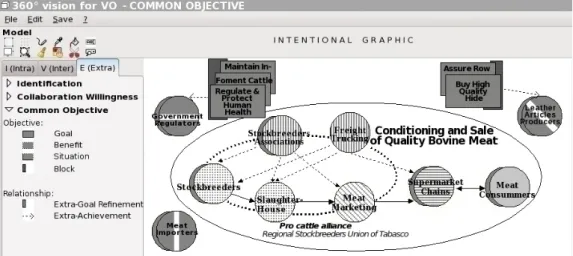
Common Objective 119
Common Objective 121
- Situations
Perks and Situations are labeled to make it easier to search for them on a common target's description screen (eg G1-B1, G1-S1 meaning that Target 1 has a Perk 1 and a Situation 1). One of the benefits is that "Maximizing the use of transport equipment" is described as financial, with an event-driven frequency and a direct impact.
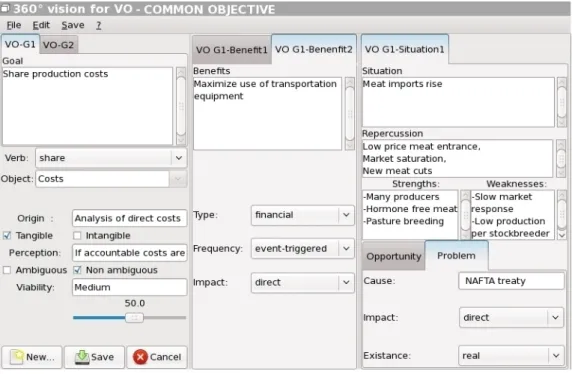
The intentional method cycle 123
The intentional method cycle
Another case (case (c)) may be an organization willing to apply for funding and seek partners to join it, the organizations will need to define and agree on common objectives that may initially don't be too clear. a) from the Identification of the Alliance (b) from the Common Objective. At the intentional level, the proposal aims to identify the VO and its participating organizations (Alliance Identification), characterize the cooperation (Will to Cooperation) and define objectives (Common Objective).
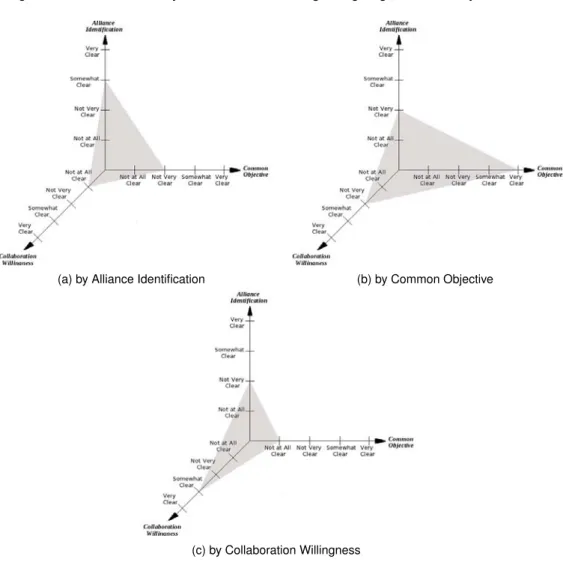
Towards the Organizational Level
Business Process Modeling Notation
Business Process Modeling Notation 127
Artifacts are elements that can be added to a diagram to provide the context appropriate for a specific modeling situation. These diagrams include pools and message flow between the pools, they allow all combinations of pools, process and choreography.
Business Process Modeling Notation 129
From Intentional to Organizational 131
From Intentional to Organizational
- Notation
MOs are the part of the virtual organization related to members who facilitate the provision of services. COs the part of the virtual organization associated with contributors who facilitate the service and.
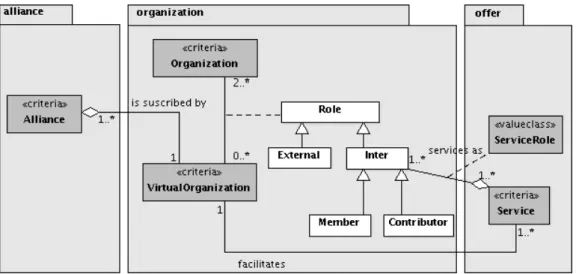
From Intentional to Organizational 133
- Mapping the Alliance Identification aspect
It is important to note that the BPMNProcess created by Rules 2 to 4 will allow nesting the organizations in aBPMNPool. The MO'senCOsBPMNProses are decomposed in the Subsection 7.2.3 which makes it possible to organize and categorize their activities, this decomposition does not consider the EOs.
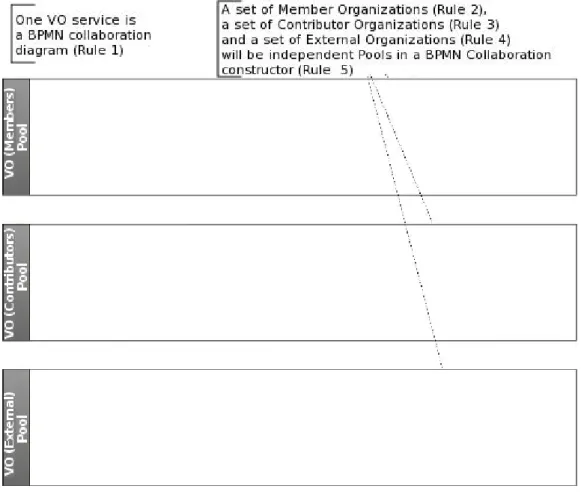
From Intentional to Organizational 135
From Intentional to Organizational 137
To complete the first part of the transformation process, rules 10 and 11 define the BPMN constructs that establish the relationships between the service roles played by the organizations participating in the service.
From Intentional to Organizational 139
The member organizations (livestock associations, livestock farmers, slaughterhouses, freight transport and meat marketing) and the “semi-fencing facade” are in the “UGRT members” pool. They have a sub-process called service role: “Provide grass-fed cattle” for the farmer, shown in the model of Figure 6.7.
From Intentional to Organizational 141
From Intentional to Organizational 143
- Mapping the Collaboration Willingness aspect
From the inclusion sub-view, we start the construction of the BPD with investment criteria as explained in subsection 6.2.1, but the investments are elements that each member organization gives to the VO. It can be triggered by a timer start event when a specific cycle or time date exists, or by a conditional start event when a condition becomes true.
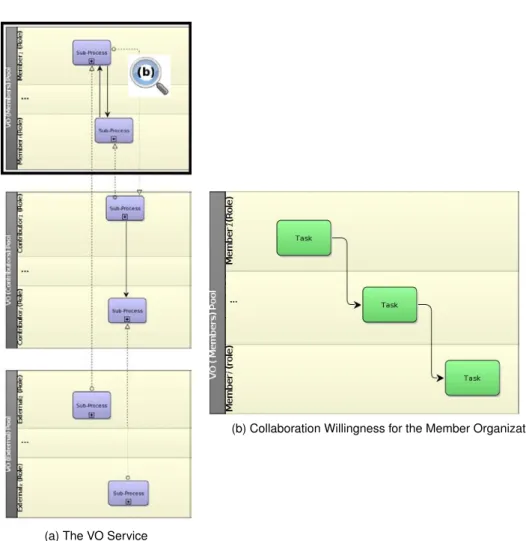
From Intentional to Organizational 145
Section 6.2.2 explains the Coordination sub-aspect and gives an example of coordination between the Stock Breeders and the Stock Breeder Associations for the “Manager”.

From Intentional to Organizational 147
It includes the livestock farmer only because freedom of action is stated, which means that no other member controls the regulation. Exclusive gateway to decide next actions (Are the parameters met?) Regarding the mapping aspect of the common goal, BPMN does not associate business goals with BP, it assumes that aBP exists because it helps to achieve a business goal.

From Intentional to Organizational 149
The 360˚ vision for VO validation
- Experiment set up
- Hypothesis
- Protocol
- Experiment set up 153
- Experiment set up 155
- Experiment development
- Experiment results
- Concepts and Relations Dictionaries clearness and completeness
- Experiment results 157
- Experiment results 159
- Experiment results 161
- Graph and Textual Models clearness, completeness and usability
- Experiment results 163
- Experiment results 165
- Models utility The hypothesis tested wereThe hypothesis tested were
- Participants opinion about the methodology
- Experiment results 167
- Conclusion 169
- Conclusion
Participants take the given material and instantiate the CW model for a scenario arrangement. Participants take the given material and instantiate the CO model for a scenario organization.

Conclusions and Future Research
- Main contribution of the thesis
- Future Research
- Future Research 173
- Les questions et les objectifs de recherche
- Structure de la thèse 177
- Les contributions
- Structure de la thèse
- Structure de la thèse 179
Toutes ces approches abordent le problème de l'identification des besoins à travers des objectifs, des scénarios ou des services. Faire émerger des besoins extra-organisationnels : il s’agit plus précisément d’étudier l’environnement externe de l’organisation virtuelle.
![Figure 3.2: Strategy links the enterprise and its industry environment as socially based (adapted from [Woolfe et al., 2002] and [Fleisher et al., 2007])](https://thumb-eu.123doks.com/thumbv2/1bibliocom/464926.70304/39.892.162.732.161.491/figure-strategy-enterprise-industry-environment-socially-adapted-fleisher.webp)
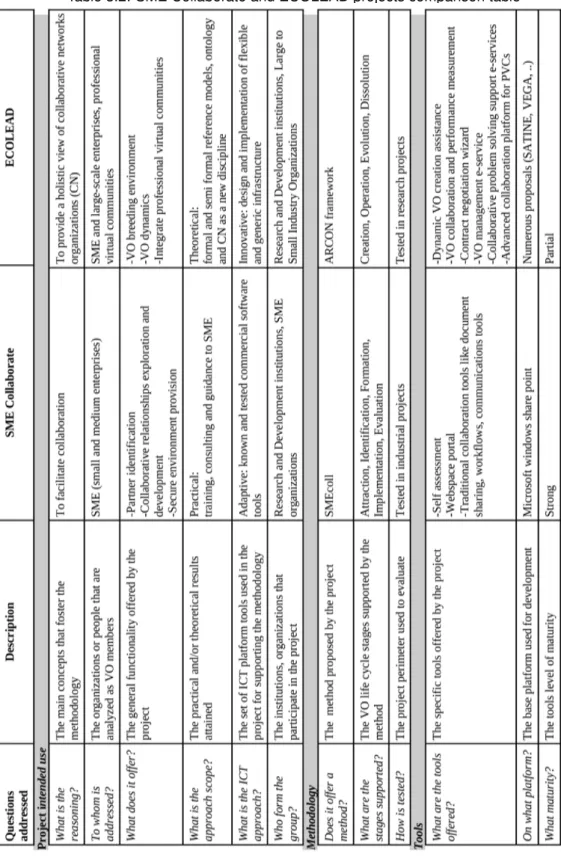
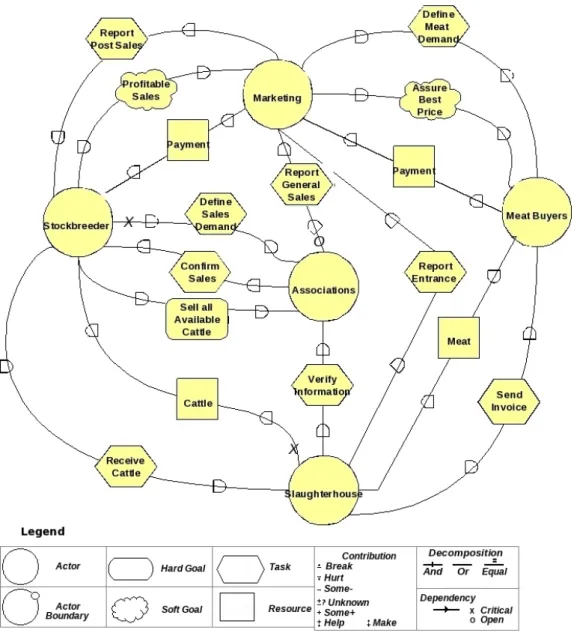
![Figure 4.6: KAOS Meta Model adapted from [Dardenne et al., 1993, Heaven et al., 2004]](https://thumb-eu.123doks.com/thumbv2/1bibliocom/464926.70304/79.892.170.746.312.617/figure-kaos-meta-model-adapted-from-dardenne-heaven.webp)
